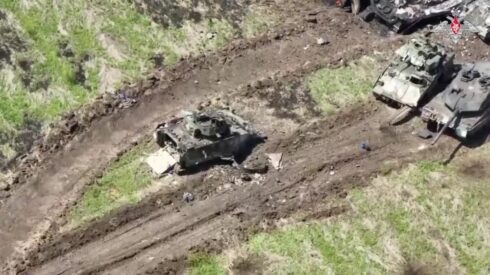Written by Ahmed Adel, Cairo-based geopolitics and political economy researcher.
The US will waste another $325 million replacing armoured vehicles destroyed by Russian forces in Ukraine’s costly counteroffensive. In addition, even though the US and its NATO allies are experiencing economic crises and have stripped their military arsenals to fuel their proxy conflict with Russia, they are doubling down with long-range cruise missiles and radioactive depleted uranium munitions.
Two anonymous US Department of Defense officials leaked the plans to the media on June 12, ahead of the official announcement a day later.
Accordingly, the US will send additional M2 Bradley Infantry Fighting Vehicles (IFVs) to replace those lost fighting on the southern front in Zaporozhye. US media have previously reported that 16 of the 109 Bradley IFVs supplied have been destroyed, with two more damaged. This was double the number released by the Russian Ministry of Defence of eight Bradleys destroyed on June 11.
On June 13, the Russian Ministry of Defence released a video of troops capturing damaged and abandoned Bradley and German-made Leopard 2 main battle tanks. Several newly formed brigades, trained and equipped by NATO member states, had launched major attacks against deeply echeloned Russian defences a week earlier on June 4.
Since then, they have suffered thousands of casualties and lost hundreds of tanks and other armoured vehicles, including at least 15 Leopard 2s. When asked by reporters about the counteroffensive on June 10, Ukrainian President Volodymyr Zelensky cryptically replied that “counteroffensive and defensive actions are taking place.”
Zelensky made his comments at a news conference with Canadian Prime Minister Justin Trudeau, who made a surprise visit to Kiev with Deputy Prime Minister Chrystia Freeland — the granddaughter of a top Ukrainian Nazi collaborator — to announce another $500 million in military aid to Ukraine.
The new American package includes an undisclosed number of anti-aircraft systems, Javelins and Stingers and 15 Bradley armoured infantry vehicles, ten Stryker armoured vehicles, AT-4 anti-aircraft systems, TOW missiles and additional munitions for advanced surface-to-air missile delivery systems (Nasams), the US Department of Defense said in a press release on June 13.
The package is the second over the last week. On June 9, the Biden government announced a $2.1 billion military aid package with ammunition for air defence systems and drones.
Germany, Denmark, and the Netherlands will also send up to 110 of the lightly armoured Leopard 1 tanks dating from the 1960s between July and the end of the year. A squadron of 14 Challenger 2 main battle tanks already supplied by the UK has yet to be seen in action.
At the same time, according to Finnish outlet Helsingin Sanomat, three Leopard 2R vehicles, which Finland had transferred to Ukraine, had been destroyed. Helsinki transferred six mine clearance vehicles based on the German Leopard 2 tank. Helsingin Sanomat writes that the fact checker confirmed the authenticity of the images from the Zaporozhye region, in which the destroyed Finnish vehicles were recorded.
On June 12, the Ministry of Defence of Finland refused to comment on the destruction in Ukraine of combat vehicles transferred to Kiev as part of military assistance and aggression against Russia. Since February 2022, Finland has delivered 16 military aid packages worth around €1.1 billion to Ukraine.
At the same time, another Ukrainian ally and military aid provider, Germany, says it cannot replace every Leopard tank Ukraine loses, but the supply of repaired ones will increase.
“It is impossible to replace every tank now withdrawn from combat. But what we are going to do […] is to increase deliveries of repaired Leopard 1A5 tanks from July. And by the end of the year, there will be more than 100,” German Defence Minister Boris Pistorius told RTL Direkt when discussing the recently destroyed Leopard 2 tanks.
In addition to the huge material loss, which is bleeding Western militaries, since June 4, Ukrainian forces have suffered approximately 7,500 casualties, including dead and wounded. This demonstrates that the long-awaited Ukrainian “spring” offensive has turned out to be an overhyped audition for more weapons and money.
Although Ukraine announced on June 12 that its troops had captured a string of villages from Russian forces along an approximately 100-kilometre front in the southeast since starting its long-anticipated counteroffensive, as expected, Russian forces recaptured some territory that they ceded in recent days.
No serious expert expected the Ukrainian counteroffensive to amount to anything. Still, given Kiev’s and the media’s hype behind it, weapons and money are being endlessly poured into Ukraine even though the country does not have the manpower or capability to utilise it to a helpful effect.


